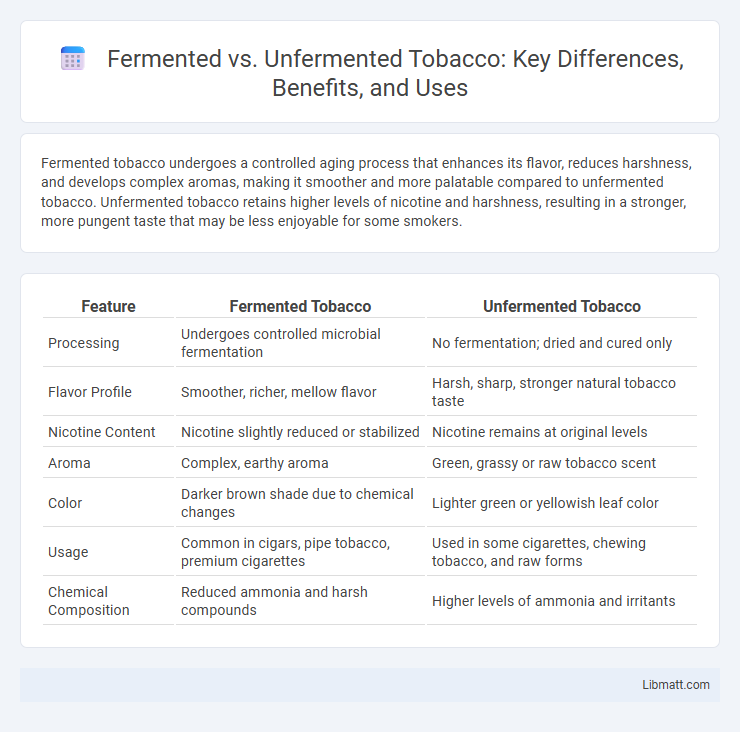Fermented tobacco undergoes a controlled aging process that enhances its flavor, reduces harshness, and develops complex aromas, making it smoother and more palatable compared to unfermented tobacco. Unfermented tobacco retains higher levels of nicotine and harshness, resulting in a stronger, more pungent taste that may be less enjoyable for some smokers.
Table of Comparison
| Feature | Fermented Tobacco | Unfermented Tobacco |
|---|---|---|
| Processing | Undergoes controlled microbial fermentation | No fermentation; dried and cured only |
| Flavor Profile | Smoother, richer, mellow flavor | Harsh, sharp, stronger natural tobacco taste |
| Nicotine Content | Nicotine slightly reduced or stabilized | Nicotine remains at original levels |
| Aroma | Complex, earthy aroma | Green, grassy or raw tobacco scent |
| Color | Darker brown shade due to chemical changes | Lighter green or yellowish leaf color |
| Usage | Common in cigars, pipe tobacco, premium cigarettes | Used in some cigarettes, chewing tobacco, and raw forms |
| Chemical Composition | Reduced ammonia and harsh compounds | Higher levels of ammonia and irritants |
Introduction to Fermented vs Unfermented Tobacco
Fermented tobacco undergoes a controlled microbial aging process that alters its chemical composition, enhancing flavor complexity and reducing harshness compared to unfermented tobacco, which retains a fresher, more robust nicotine profile. The fermentation transforms sugars and proteins, producing aromatic compounds that contribute to smoother smoke and improved taste, while unfermented tobacco is often preferred for products requiring stronger nicotine delivery and more intense strength. Understanding these distinctions is crucial for selecting tobacco types in cigarette manufacturing, pipe smoking, and cigar production.
What Is Fermented Tobacco?
Fermented tobacco undergoes a controlled aging process where natural microbes break down sugars and other compounds, enhancing flavor complexity and reducing harshness compared to unfermented tobacco. This fermentation improves tobacco's aroma, smoothness, and combustibility by altering chemical composition, including nicotine and sugar levels. Understanding these differences helps you choose tobacco products that best suit your taste preferences and smoking experience.
What Is Unfermented Tobacco?
Unfermented tobacco, often referred to as "bright leaf" tobacco, is harvested and cured without undergoing the traditional fermentation process, preserving its natural chemical composition and lighter, sweeter flavor profile. Unlike fermented tobacco, which is aged and exposed to microbial action to develop richer aromas and reduce harshness, unfermented tobacco retains higher nicotine content and stronger alkaloid compounds, impacting its harshness and potency. This type of tobacco is commonly used in products requiring a fresher, more robust taste such as certain cigarettes and chewing tobaccos.
Key Differences Between Fermented and Unfermented Tobacco
Fermented tobacco undergoes a controlled aging process that reduces harshness, enhances flavor complexity, and increases nicotine content, whereas unfermented tobacco retains a more natural, raw taste with higher sugar and chlorophyll levels. The fermentation process involves microbial activity that breaks down undesirable compounds, resulting in smoother smoke and richer aroma compared to the often harsher and more pungent qualities of unfermented leaf. Understanding these key differences can help you choose tobacco that matches your preference for taste intensity and smoking experience.
Fermentation Process Explained
The fermentation process of tobacco involves controlled microbial activity that breaks down sugars and proteins, enhancing flavor complexity and reducing harshness. Fermented tobacco undergoes aerobic or anaerobic conditions at regulated temperature and humidity, which develops unique aromatic compounds and decreases unwanted substances like ammonia. Unfermented tobacco lacks this biochemical transformation, resulting in a harsher taste and less refined aroma.
Chemical Changes in Tobacco Fermentation
During tobacco fermentation, complex chemical changes occur that significantly alter the composition and flavor profile of the tobacco leaves. Natural enzymatic reactions break down proteins, carbohydrates, and alkaloids, reducing harshness and producing desirable aromatic compounds such as aldehydes and esters. Understanding these chemical transformations helps you select tobacco that delivers a smoother, more refined smoking experience compared to unfermented tobacco, which retains higher levels of bitterness and undesirable impurities.
Flavor Profile: Fermented vs Unfermented Tobacco
Fermented tobacco undergoes a controlled aging process that develops complex flavor profiles with richer, smoother, and often sweeter notes, enhancing the smoking experience. Unfermented tobacco retains a fresher, more raw taste with sharper, sometimes harsher flavors due to the absence of the chemical transformations that fermentation induces. Your choice between fermented and unfermented tobacco significantly impacts the flavor intensity and smoothness, catering to different palate preferences.
Health Implications: Fermented vs Unfermented Products
Fermented tobacco undergoes microbial processing that can reduce certain harmful compounds but may increase others like nitrosamines, contributing to higher health risks such as cancer. Unfermented tobacco retains more natural alkaloids and fewer toxic byproducts, potentially lowering exposure to some carcinogens but still posing significant health dangers due to nicotine and tar content. Your choice between fermented and unfermented tobacco affects the type and level of toxicants inhaled, impacting respiratory and cardiovascular health differently.
Popular Products Using Fermented and Unfermented Tobacco
Popular products using fermented tobacco include cigars, pipe tobacco, and certain types of chewing tobacco, valued for their rich flavor and reduced harshness achieved through the fermentation process. In contrast, unfermented tobacco is commonly found in products like some cigarette blends and snuff, offering a fresher, greener taste with higher nicotine content and stronger potency. Fermented tobacco undergoes microbial and enzymatic changes that enhance aroma and smoothness, while unfermented tobacco retains more natural sugars and alkaloids, affecting flavor profiles and user experience.
Choosing Between Fermented and Unfermented Tobacco
Choosing between fermented and unfermented tobacco depends on your preference for flavor and aroma intensity. Fermented tobacco undergoes a curing process that enhances its smoothness, richness, and complexity by reducing harshness and developing deep, earthy notes. Unfermented tobacco retains a stronger, more natural nicotine bite with a fresh, grassy profile but can be harsher on the palate.
fermented vs unfermented tobacco Infographic

 libmatt.com
libmatt.com